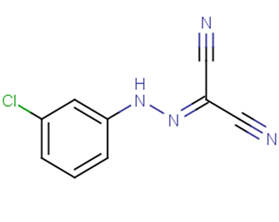
CCCP
CAS No. 555-60-2
CCCP( CCCP | Mesoxalonitrile 3-chlorophenylhydrazone )
Catalog No. M18806 CAS No. 555-60-2
CCCP inhibits activation of STING and its downstream signalling molecules, TBK1 and IRF3. CCCP inhibits STING-mediated IFN-β production via disrupting mitochondrial membrane potential (MMP).
Purity : >98% (HPLC)
 COA
COA
 Datasheet
Datasheet
 HNMR
HNMR
 HPLC
HPLC
 MSDS
MSDS
 Handing Instructions
Handing Instructions
| Size | Price / USD | Stock | Quantity |
| 100MG | 37 | In Stock |


|
| 200MG | 52 | In Stock |


|
| 500MG | 87 | In Stock |


|
| 1G | Get Quote | In Stock |


|
Biological Information
-
Product NameCCCP
-
NoteResearch use only, not for human use.
-
Brief DescriptionCCCP inhibits activation of STING and its downstream signalling molecules, TBK1 and IRF3. CCCP inhibits STING-mediated IFN-β production via disrupting mitochondrial membrane potential (MMP).
-
Descriptionm-Cl-CCP [555-60-2] is a protonophore (h+ ionophore) and uncoupler of oxidative phosphorylation in mitochondria, inhibiting secretion of hepatic lipase and partially inhibiting the ph gradient-activated cl- uptake and cl-/cl- exchange activities in brush-border membrane vesicles(In Vitro):CCCP inhibits IFN-β production induced by various types of the STING pathway activators. CCCP suppresses the phosphorylation of STING, TBK1, and IRF3 via disrupting the association of STING and TBK1. CCCP inhibits activation of STING and its downstream signaling molecules, TBK1 and IRF3, but not STING translocation to the perinuclear region. CCCP impairs the interaction between STING and TBK1 and concomitantly triggers mitochondria fission. Importantly, the knockout of the crucial mitochondria fission regulator Drp1 restored the STING activity, indicating that CCCP down-modulates the STING pathway through DRP1-mediated mitochondria fragmentation. The protonophore CCCP that disrupts membrane potential suppresses the DMXAA-triggered STING signaling pathway. CCCP drastically suppresses the production of IFN-β in DMXAA-treated RAW264.7 cells and MEFs.As low as 1 μM CCCP is enough to induce mitocytosis. In cells treated with 10 μM CCCP, which is the dose used for inducing mitophagy, mitocytosis is barely induced. Mechanistically, mitocytosis requires positioning of damaged mitochondria at the cell periphery, which occurs because damaged mitochondria avoid binding to inward motor proteins. (In Vivo):The same dosage of 3?mg/kg.bw each of CCCP and PPEF is used. In both the cases 1?log reduction is observed in the bacterial load. However, when 3?mg/kg.bw of PPEF is used in combination with 3?mg/kg.bw of CCCP, 6 log10 reduction is observed in the bacterial count. The developed model validates the enhanced antibacterial activity of combination therapy.99mTc-MIBI signals in the hearts of SD rats administered CCCP (4 mg/kg intraperitoneally) or vehicle is also measured. 99mTc-MIBI signals decrease in rat hearts administered CCCP, and the ATP content, as measured by 31P magnetic resonance spectroscopy, decreased simultaneously. To investigate whether CCCP decreased the 99mTc-MIBI signals in rats, we analyzed the radioisotope activity of excised heart tissue from rats administered CCCP. At 180 min after 99mTc-MIBI injection, the 99mTc-MIBI signals from the hearts in the CCCP group are significantly lower than those in the vehicle group.
-
In Vitro——
-
In Vivo——
-
SynonymsCCCP | Mesoxalonitrile 3-chlorophenylhydrazone
-
PathwayOthers
-
TargetOther Targets
-
RecptorTBK1| IFN-β
-
Research Area——
-
Indication——
Chemical Information
-
CAS Number555-60-2
-
Formula Weight204.62
-
Molecular FormulaC9H5ClN4
-
Purity>98% (HPLC)
-
SolubilityDMSO : ≥ 150 mg/mL; 733.07 mM
-
SMILESClc1cccc(NN=C(C#N)C#N)c1
-
Chemical NameCarbonyl cyanide 3-chlorophenylhydrazone
Shipping & Storage Information
-
Storage(-20℃)
-
ShippingWith Ice Pack
-
Stability≥ 2 years
Reference
1. Kwon D, et al. Biochem Biophys Res Commun. 2017 Aug 30. pii: S0006-291X(17)31704-7.
molnova catalog



related products
-
Tricine
Tricine can clearly visualize tumors, may as melanoma imaging agents. Using the combination of tricine and a phosphine ligand, HYNIC-derivatized peptides or other small molecules can be labeled with 99mTc in high specific activity and with high stability for potential use as radiopharmaceuticals.
-
10-O-trans-p-Feruloy...
The herbs of Hedyotis diffusa Willd.
-
Notoginsenoside Ft1
Notoginsenoside Ft1 is a saponin originally isolated from P. notoginseng with diverse biological activities.



 Cart
Cart
 sales@molnova.com
sales@molnova.com


